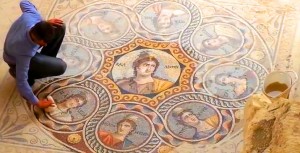Amazing Mosaics discovered in Ancient City of Zeugma
An international team of archaeologists has unearthed three 2,200-year-old, well-preserved glass mosaics at the site of the olden city of Zeugma in Turkey. The incredibly well preserved mosaics date back to the 2nd century BC, but they’re still as gorgeous as the first day.
The olden city of Zeugma, also known as Seleukia-on-the-Euphrates, is located in modern Gaziantep province, where the Euphrates River rounds its utmost bend to the west and begins to flow south into the Syrian Desert.
It was discovered in 300 BC by Seleucus I Nicator – one of the generals of Alexander the Great – who named the city after himself.
In 64 BC the city was occupied by the Roman Empire and with this shift the name of the city was changed into Zeugma.
Across the Taurus Mountains from Anatolia and across the Euphrates from Mesopotamia, the city was forever between large cultural forces, but never entirely part of any one.
The city is well known for its construction, which spans centuries and gives a peek into Hellenistic and Roman civilization on the Euphrates frontier.
Zeugma mosaics have long been known for their exquisite detail and beauty. One of the most famous is the Gypsy Girl.The team led by Prof Kutalmis Görkay of Ankara University unearthed three remarkably whole glass mosaics at the site.The first depicts the nine Muses – the goddesses of the motivation of literature, science and the arts. Muse Calliope is in the center of the mosaic.
The second mosaic depicts Ocean – the divine image of the sea – and his sister Tethys. The third, smaller in size mosaic, depicts a young man.
According to the team, all mosaics are constructed of colored glass and served as floors of a construction that archaeologists have dubbed the House of Muses.
